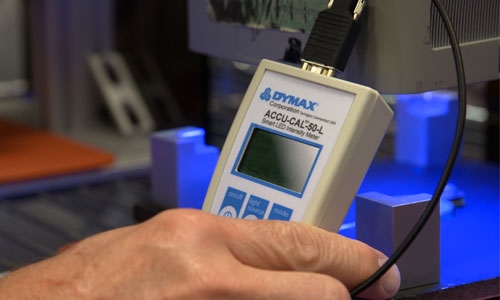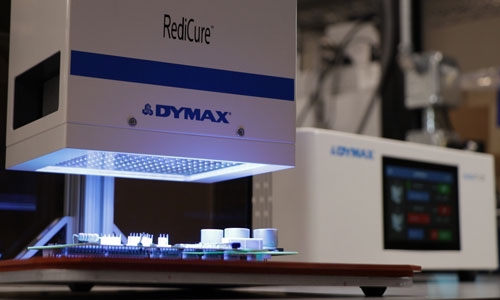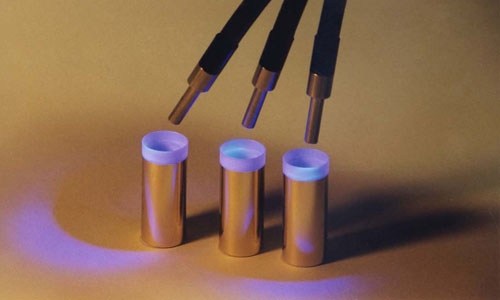Maintain a Consistent Light-Curing Control Process
Once a spot or flood light-curing process is set up and validated, it’s important for manufacturing to continue to operate within the defined limits of the process. Here are five ways to help maintain consistent process control:
1) Monitor the Intensity
Measuring intensity requires a radiometer, like the Dymax ACCU-CAL™ 50 or the ACCU-CAL™ 160, that measures light intensity over a specified range of wavelengths. With spot-curing systems, intensity is best measured at the end of a lightguide, although a lightguide simulator may be used to distinguish bulb intensity from lightguide transmission. Measurement of lightguide's UV transmission can identify if a lightguide is dirty or has been damaged.
The intensity of a flood system is best measured at the focal point of the lamp reflector. The focal point of a Dymax flood lamp is 3.0” (76 mm) beneath the bottom of the lamp reflector, and the focal point of a Dymax LED flood lamp is 1.0” (25 mm) below the bottom of the LED array housing. Recording intensities is necessary to document the health of the curing system and verify that the process is operating within the limit set during the validation.
2) Adjust the Intensity
Some light-curing systems allow users to adjust intensity manually or automatically. Since light intensity tends to drop with time (whether manually or automatically controlled), the intensity set-point should be set closer to the upper-intensity limit and be periodically checked and readjusted.
In standard arc-ignition systems, the intensity adjustment is performed by moving the z-axis distance from the bond line. Increasing the distance from the UV source to the bond line will decrease the intensity. The technology in the new LED flood systems allows for adjustments in output intensity simply through the front panel display, leaving the lamp to bond line distance untouched.
3) Maintain the Lightguides
Dirty lightguides are the most common problem associated with the proper operation of spot-curing systems. Adhesives are the most common contaminants, but adhesive vapors can also build up. In some applications, you may notice vapors emitting from the adhesive during the curing exposure step. These vapors can deposit on the end of the lightguide and reduce lightguide transmission by more than 50%. Because these vapors and cured adhesive residue are often chemically resistant, wiping with a solvent-soaked cloth is typically ineffective due to the solvent resistance of many light-curable materials. Scraping with a razor blade is often the best way to clean the end of a liquid or fused fiber optic lightguide. Epoxied fiber-optic lightguides often require soaking in solvent.
Lightguides also degrade with use. Frequent bending or wrapping of a lightguide may reduce its ability to transmit light faster than a stationary lightguide. Lightguides that are kinked or show signs of transmission loss should be replaced.
4) Document the Process
Documentation methods and measurements are critical to any manufacturing process and should be posted at the workstation, not filed away. The readily available documentation is more likely to be followed and is strongly recommended. A UV-curing intensity record typically incorporates the following items:
- Radiometer and detector serial number and calibration date
- Intensity measurements
- Setup and shutdown procedure
- Intensity limits of the process
- Exposure time
- Distance from the lightguide to the part
- Intensity measurement method and frequency
- Lightguide cleaning method and frequency of cleaning
- Bulb replacement method and bulb change history log
5) Eliminate or Understand Possible Variations
The more variation that is eliminated from a light-curing process, the more controlled the process will be. If a variation cannot be eliminated, it should be understood and worked into the process. Sources of variation include:
Bulbs (Lamps):
Natural variations in the components that construct the bulbs used in light-curing systems will lead to variations in initial intensity output. This will be most noticeable when changing out an old lamp for a new lamp. Lamps also degrade at different rates, depending upon their initial intensity and pattern of usage, but all will exhibit similar degradation curves.
Lightguides:
The number of bends and the bend radii can alter the output of a lightguide. Multi-pole lightguides require balancing (liquid only) to increase the uniformity of intensity output between each pole. If improperly installed, a lightguide mounted to a moving component such as an XYZ table could notice increased wear and degradation over a stationary lightguide.
Radiometers:
Radiometers consist of a meter and a detector. These two components are calibrated as a matched set. Interchanging a detector between meters will certainly lead to repeated inaccurate measurements that can be wildly out of range. Each detector comes with a graphed spectral response curve, which is specific to that device like a fingerprint. The calibration process individually calibrates each radiometer set to a standard test device within an acceptable deviation limit.
When comparing two radiometers to each other, the stacking of deviations could indicate significant differences in measurement that may seem unacceptable, but each radiometer is accurate when compared to the calibration standard. For this reason, it is strongly recommended that a single radiometer be used when monitoring the daily activities of a production line.
A second radiometer should only be used when the main radiometer is returned to Dymax for calibration. At this time, the radiometers should be compared together to understand what the deviation is between the two units. This will help the user to understand the difference in measurement they may begin to witness when using the secondary radiometer.
Measurement Location:
Intensity varies dramatically with distance from the end of a lightguide, so it’s important to maintain a consistent distance from the lightguide to the part. Depending on the flood lamp curing system used, the UV intensity delivered to the bond line can vary across both the X & Y axis (length & width) of the exposed area. Placing the measuring radiometer in the same location consistently will provide consistent measurements. Variable mitigation could include the creation of a fixture to be used with the radiometer for repeatable placement in the cure area regardless of the technician recording the measurement. It is also important to make sure the intensity measure is recorded at the same Z-axis (height) as the bond line. A measurement taken with the radiometer detector 0.5” above or below the height of the bond line could produce energy levels drastically different from what the bond line is truly receiving.
If you are using a validated light-curing process, follow these critical steps to maintain accurate process control for successful, consistent manufacturing.
_________________________________________________________
Enjoying This Content? Let’s Stay Connected.
If you’re finding value in our insights, why not get more of it—delivered right to your inbox? Subscribe to receive the latest technical articles, white papers, product news, and expert tips.



